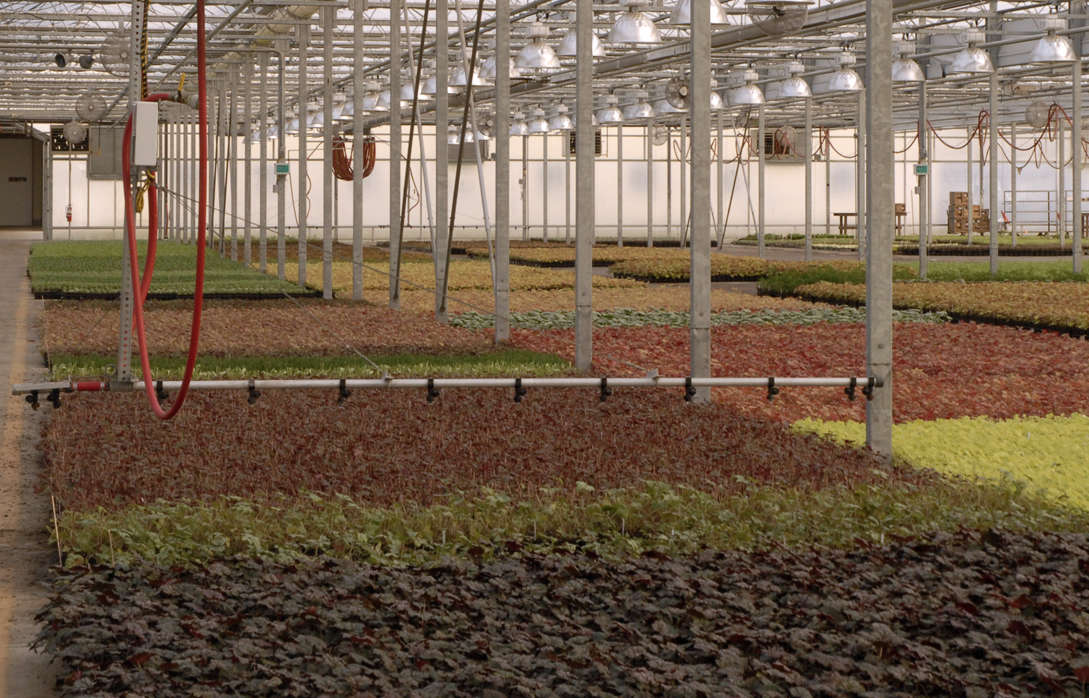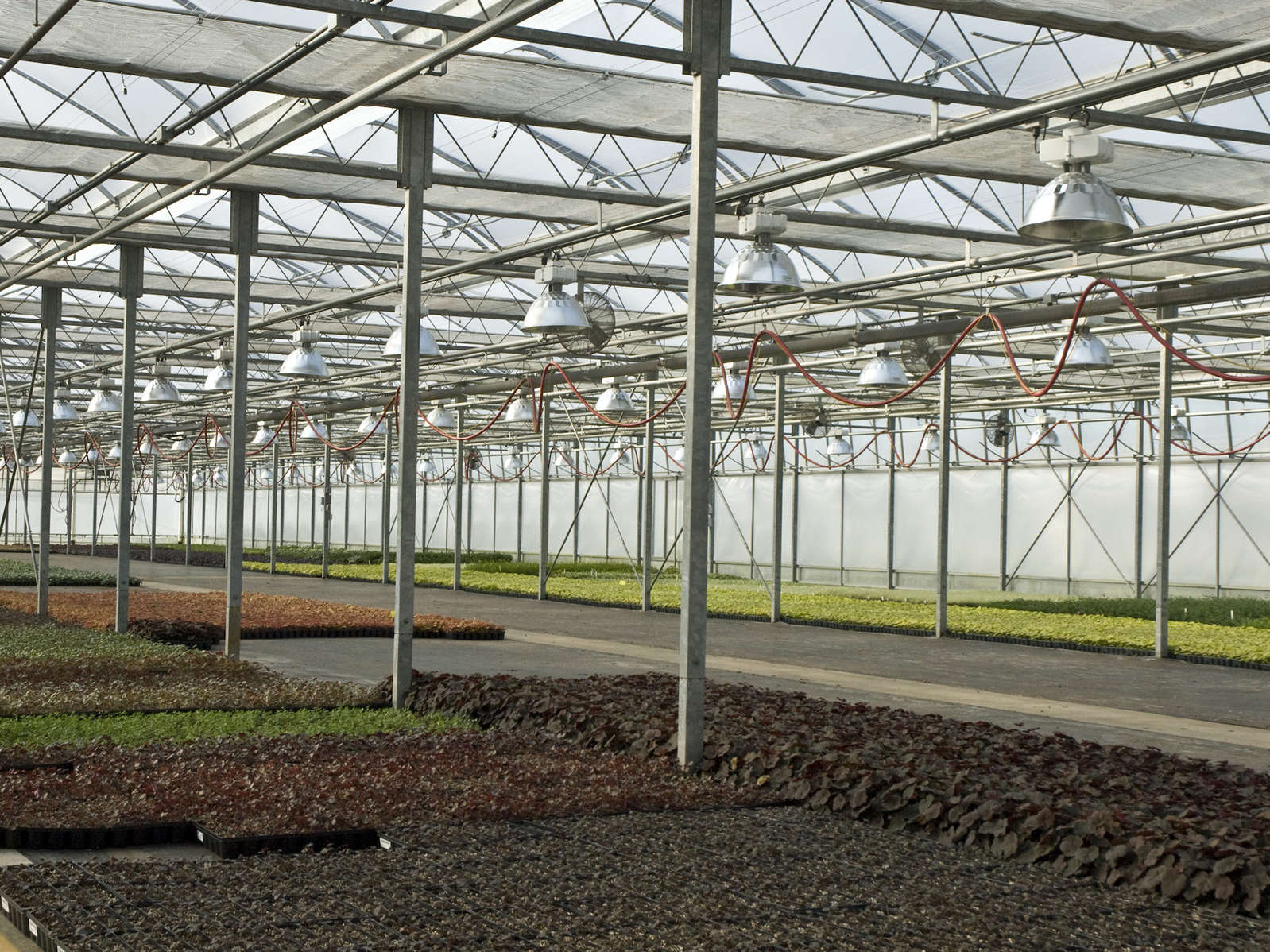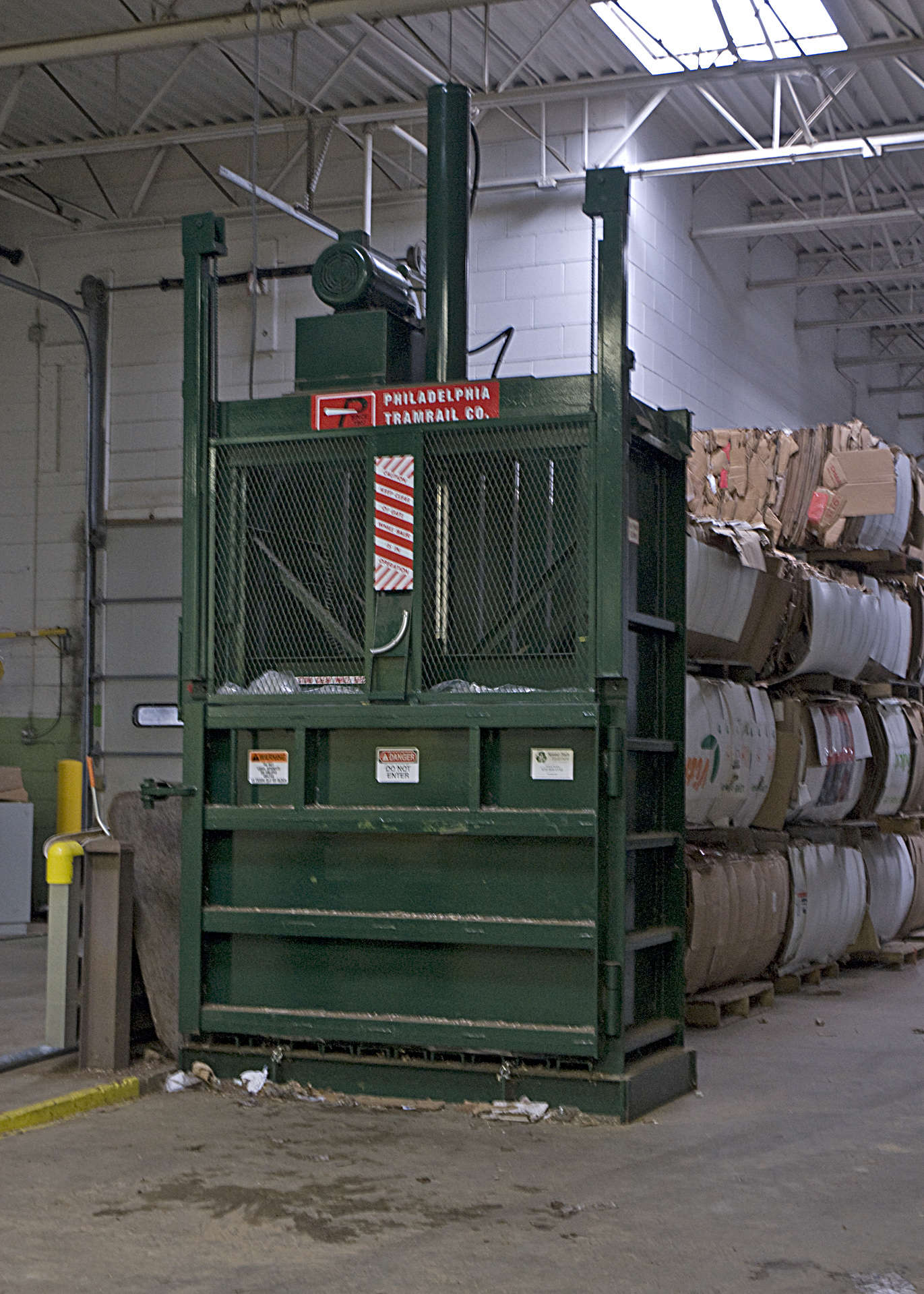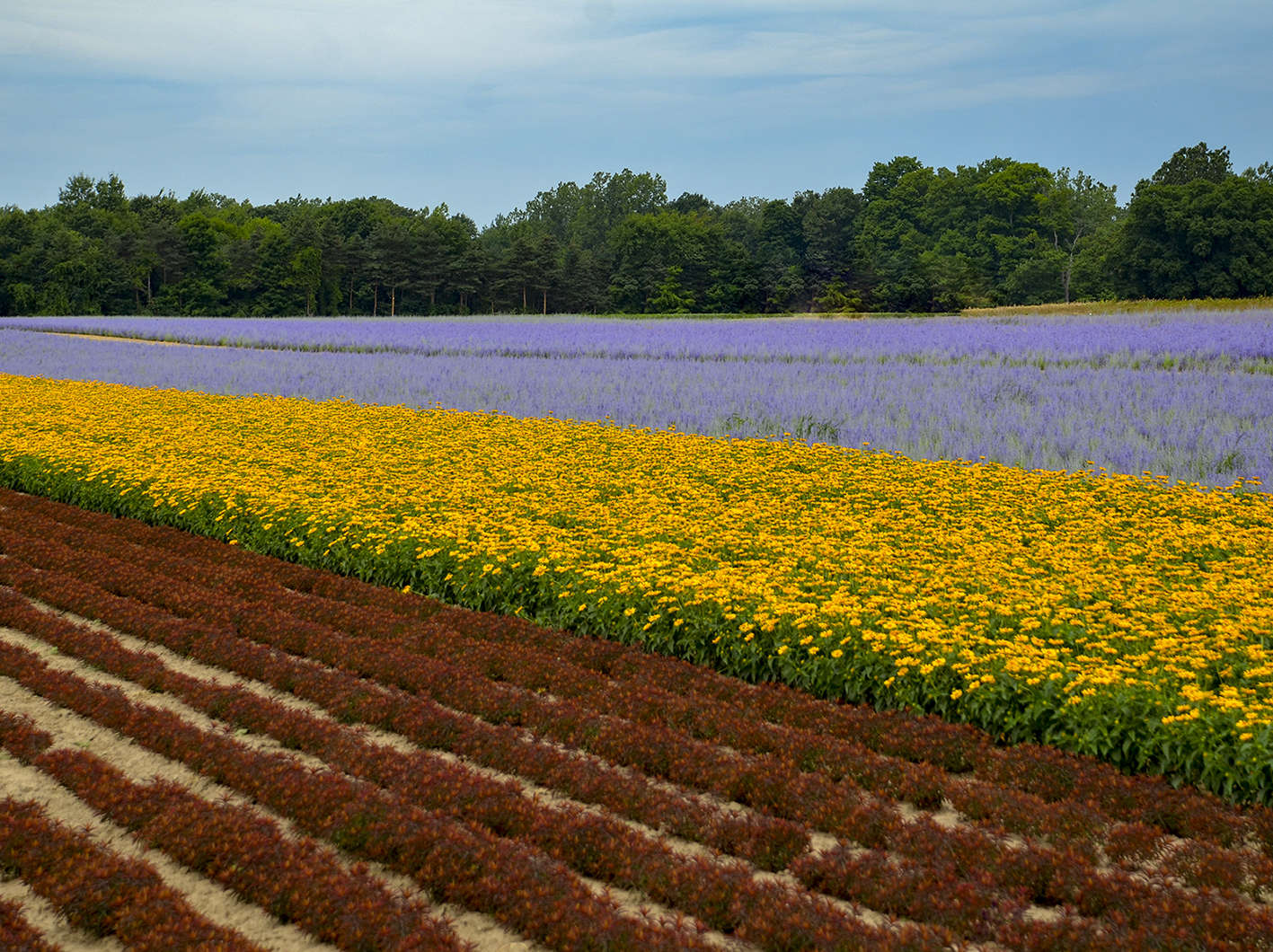Limiting Our Environmental Impact
Over the past decade, Walters Gardens, Inc. has made tremendous strides in reducing the amount of waste we produce, reusing what we can, and recycling an enormous amount of material. Though there will always be room for improvement, we are proud to be doing our part to limit our environmental impact.
Conservation Efforts

Efficient watering booms help to conserve water and fertilizer.
In the Greenhouse
Upon review of our greenhouse growing practices a few years ago, we came to the conclusion that we were pampering our plants a little too much. We were giving them too much fertilizer and growing them warmer than necessary in the winter. This sometimes resulted in stressed plants that did not ship well. Since that time, we have overhauled the way we grow many of our plants. Soil and water tests have shown us exactly what the plants need to be healthy and not grown to excess. Now, they are stronger than ever and are shipping better too. Our customers have noticed the difference, remarking on the exceptional quality of our plants.
Of course, fewer inputs has resulted in savings since less water, fertilizer, and chemicals need to be applied. Perhaps less obvious is the effect that fewer inputs has had on the roots and tops of the plants. Whereas our perennial liners used to have lush top growth, we have found that reducing the inputs results in a larger root mass and shorter top growth which is preferred by our customers. In addition, we only need to trim the top growth once every 1-1½ months instead of every week, saving in labor costs and waste disposal, and reducing the risk of spreading disease between plants.
In 2004, we added two new 59,000 square foot DeCloet brand greenhouse ranges to our main growing facility. Of their many modern features, the new watering booms have helped us conserve water and fertilizer, reduce labor costs, and produce a more uniform crop. We now have the ability to program the booms to deliver exactly the amount of water and fertilizer each group of plants needs and skip over the spots that do not require inputs. The water and fertilizer is delivered just inches from the tops of the plants so little is lost to evaporation and every plug receives an equal amount of inputs, resulting in a more uniform crop.

An energy curtain saves about 35% per year in heating this greenhouse.
Environmentally Friendly Solutions
An energy curtain saves about 35% per year in heating this greenhouse. In addition to the watering booms, our new greenhouse ranges have an energy curtain that helps conserve heat on cool nights and shade plants on sunny days. It is computer controlled by temperature and sunlight. The energy curtain saves us an average of 45% in heating costs in these warm greenhouse ranges each winter. A federal grant from the USDA was received to supplement the cost of the energy curtain in 2005. Another way we conserve energy in the new greenhouse ranges is with roof vents which serve as the primary method of passive cooling. No electricity is used in this process and additional energy is saved by not having to run the electric exhaust fans as frequently.
The Paperless Office
As recent as one decade ago, 256 square feet of our office was occupied by large file cabinets filled with paper copies of acknowledgements, shippers, invoices, and accompanying documentation. We accumulated approximately 324,000 pieces of paper or 1,080 reams each year-some estimate this is the equivalent of 4 trees-and then moved all of it to the attic for storage at the beginning of each new fiscal year. All of this accumulated documentation took up over 4,000 cubic feet of attic space.
Storing documentation electronically helps to conserve paper and space. Now we operate a "paperless" office, meaning that the documentation is scanned into the computer, stored electronically on our servers, and the originals are mailed to the customers. Our paper usage has been reduced by 67% and employee cubicles now fill the space where file cabinets once stood. Our attics are empty since eight years of documentation now fit on six secure hard drives that fill two square feet of space in a fireproof safe.
Reusable Items
Several items used in producing and processing plants are reused here at Walters Gardens, Inc. In our tissue culture lab, we use sterilized glass culture vessels instead of disposable plastic ones. Some of the vessels date back as far as the mid-1970s when we first opened our lab. We also use sterilized Petri dishes instead of paper towels or some other non-reusable product for processing tissue culture material. In the processing department, we are constantly reusing and repairing the wooden cribs used to hold harvested bare root material. We also reuse skids, sterilized planter trays for field prop stock, and the knives used to cut bare root plants to grade. In addition, our customers have reported that they are able to reuse or repurpose the wooden racks on which they receive their plant shipments.

A baler prepares cardboard and plastic to be recycled.
Recycling Program
We've come a long way when it comes to recycling at Walters Gardens, Inc. and we're still looking for new ways to recycle today. Just five short years ago, we only recycled office paper, cardboard, and greenhouse covering plastic. In the past year alone, we recycled over ¼ million pounds of paper, plastic, and metal products that otherwise would have ended up in the landfill. And we don't use a lot of fossil fuels to do it-a company right in town picks it up and either recycles it or sends it out to be made into new materials. Check out these numbers! (Amount is # of pounds recycled in one year.)
- Pots and trays-103,912 lbs.
- Greenhouse covering plastic-32,018 lbs.
- Plastic jugs-400 lbs.
- Miscellaneous plastic-9,052 lbs.
- Mesh soil bags-5,246 lbs.
- Cardboard-104,240 lbs.
- Office paper-5,390 lbs.
- Old labels and catalogs-9,050 lbs.
- Scrap metal-3,229 lbs.
- Electric motors-6,980 lbs.
- Obsolete computer components-1,125 lbs.
Total # of pounds of recycled materials per year = 280,642 lbs. total or over ¼ million lbs. of material.
When we grew our perennials in plastic pots, we shipped an average of 4.1 million per year to our customers. Since making the switch to biodegradable Elle Plugs, we've eliminated this waste. We are currently looking into the feasibility of an Elle Plug tray recycling program.
As you can see, it is possible to grow in a sustainable manner and be a profitable business at the same time. However, it requires a commitment by everyone involved, from the fields to the shipping room. We continually strive to find new innovations and sustainable production practices. For additional information on innovations in processing, shipping, and IT, stay tuned for articles coming soon.
Over the past decade, Walters Gardens, Inc. has made tremendous strides in reducing the amount of waste we produce, reusing what we can, and recycling an enormous amount of material. Though there will always be room for improvement, we are proud to be doing our part to limit our environmental impact.
Conservation Efforts

Efficient watering booms help to conserve water and fertilizer.
In the Greenhouse

Efficient watering booms help to conserve water and fertilizer.
Upon review of our greenhouse growing practices a few years ago, we came to the conclusion that we were pampering our plants a little too much. We were giving them too much fertilizer and growing them warmer than necessary in the winter. This sometimes resulted in stressed plants that did not ship well. Since that time, we have overhauled the way we grow many of our plants. Soil and water tests have shown us exactly what the plants need to be healthy and not grown to excess. Now, they are stronger than ever and are shipping better too. Our customers have noticed the difference, remarking on the exceptional quality of our plants.
Of course, fewer inputs has resulted in savings since less water, fertilizer, and chemicals need to be applied. Perhaps less obvious is the effect that fewer inputs has had on the roots and tops of the plants. Whereas our perennial liners used to have lush top growth, we have found that reducing the inputs results in a larger root mass and shorter top growth which is preferred by our customers. In addition, we only need to trim the top growth once every 1-1½ months instead of every week, saving in labor costs and waste disposal, and reducing the risk of spreading disease between plants.
In 2004, we added two new 59,000 square foot DeCloet brand greenhouse ranges to our main growing facility. Of their many modern features, the new watering booms have helped us conserve water and fertilizer, reduce labor costs, and produce a more uniform crop. We now have the ability to program the booms to deliver exactly the amount of water and fertilizer each group of plants needs and skip over the spots that do not require inputs. The water and fertilizer is delivered just inches from the tops of the plants so little is lost to evaporation and every plug receives an equal amount of inputs, resulting in a more uniform crop.

An energy curtain saves about 35% per year in heating this greenhouse.
Environmentally Friendly Solutions

An energy curtain saves about 35% per year in heating this greenhouse.
An energy curtain saves about 35% per year in heating this greenhouse. In addition to the watering booms, our new greenhouse ranges have an energy curtain that helps conserve heat on cool nights and shade plants on sunny days. It is computer controlled by temperature and sunlight. The energy curtain saves us an average of 45% in heating costs in these warm greenhouse ranges each winter. A federal grant from the USDA was received to supplement the cost of the energy curtain in 2005. Another way we conserve energy in the new greenhouse ranges is with roof vents which serve as the primary method of passive cooling. No electricity is used in this process and additional energy is saved by not having to run the electric exhaust fans as frequently.
The Paperless Office
As recent as one decade ago, 256 square feet of our office was occupied by large file cabinets filled with paper copies of acknowledgements, shippers, invoices, and accompanying documentation. We accumulated approximately 324,000 pieces of paper or 1,080 reams each year-some estimate this is the equivalent of 4 trees-and then moved all of it to the attic for storage at the beginning of each new fiscal year. All of this accumulated documentation took up over 4,000 cubic feet of attic space.
Storing documentation electronically helps to conserve paper and space. Now we operate a "paperless" office, meaning that the documentation is scanned into the computer, stored electronically on our servers, and the originals are mailed to the customers. Our paper usage has been reduced by 67% and employee cubicles now fill the space where file cabinets once stood. Our attics are empty since eight years of documentation now fit on six secure hard drives that fill two square feet of space in a fireproof safe.
Reusable Items
Several items used in producing and processing plants are reused here at Walters Gardens, Inc. In our tissue culture lab, we use sterilized glass culture vessels instead of disposable plastic ones. Some of the vessels date back as far as the mid-1970s when we first opened our lab. We also use sterilized Petri dishes instead of paper towels or some other non-reusable product for processing tissue culture material. In the processing department, we are constantly reusing and repairing the wooden cribs used to hold harvested bare root material. We also reuse skids, sterilized planter trays for field prop stock, and the knives used to cut bare root plants to grade. In addition, our customers have reported that they are able to reuse or repurpose the wooden racks on which they receive their plant shipments.

A baler prepares cardboard and plastic to be recycled.
Recycling Program

A baler prepares cardboard and plastic to be recycled.
We've come a long way when it comes to recycling at Walters Gardens, Inc. and we're still looking for new ways to recycle today. Just five short years ago, we only recycled office paper, cardboard, and greenhouse covering plastic. In the past year alone, we recycled over ¼ million pounds of paper, plastic, and metal products that otherwise would have ended up in the landfill. And we don't use a lot of fossil fuels to do it-a company right in town picks it up and either recycles it or sends it out to be made into new materials. Check out these numbers! (Amount is # of pounds recycled in one year.)
- Pots and trays-103,912 lbs.
- Greenhouse covering plastic-32,018 lbs.
- Plastic jugs-400 lbs.
- Miscellaneous plastic-9,052 lbs.
- Mesh soil bags-5,246 lbs.
- Cardboard-104,240 lbs.
- Office paper-5,390 lbs.
- Old labels and catalogs-9,050 lbs.
- Scrap metal-3,229 lbs.
- Electric motors-6,980 lbs.
- Obsolete computer components-1,125 lbs.
Total # of pounds of recycled materials per year = 280,642 lbs. total or over ¼ million lbs. of material.
When we grew our perennials in plastic pots, we shipped an average of 4.1 million per year to our customers. Since making the switch to biodegradable Elle Plugs, we've eliminated this waste. We are currently looking into the feasibility of an Elle Plug tray recycling program.
As you can see, it is possible to grow in a sustainable manner and be a profitable business at the same time. However, it requires a commitment by everyone involved, from the fields to the shipping room. We continually strive to find new innovations and sustainable production practices. For additional information on innovations in processing, shipping, and IT, stay tuned for articles coming soon.
